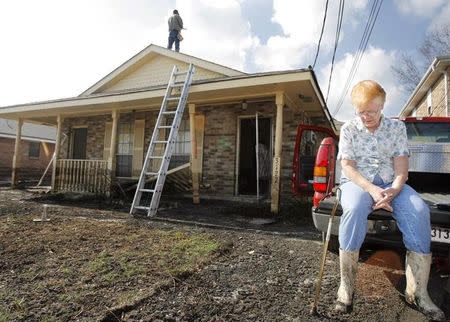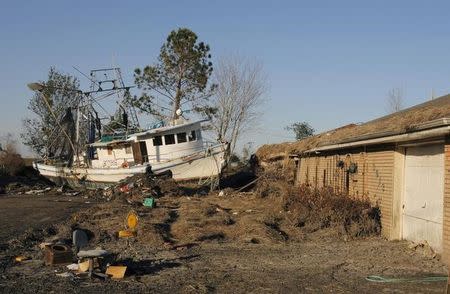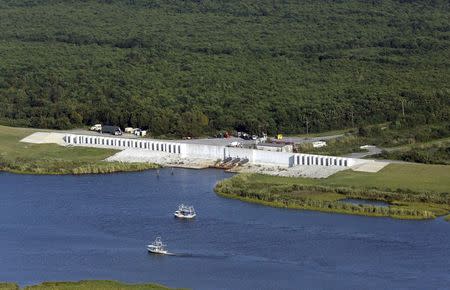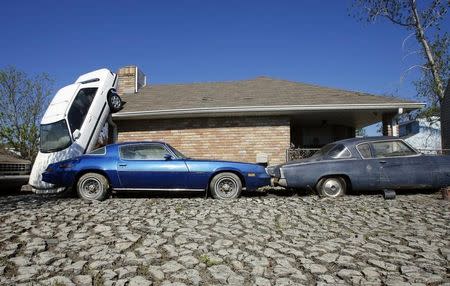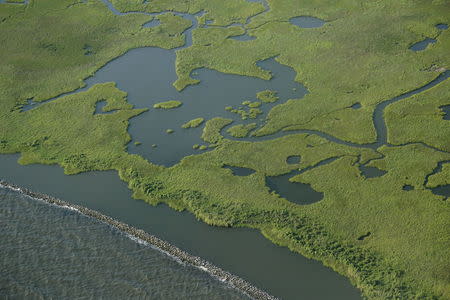Low-lying Louisiana parish regroups behind reinforced levee system
By Kathy Finn NEW ORLEANS (Reuters) - Of all the areas near New Orleans blasted by Hurricane Katrina, none was harder hit than St. Bernard Parish, a low-lying coastal stretch southeast of the city, once known for its small fishing villages and thriving seafood industry. The full force of Katrina's 125-mile-an-hour winds and a 20-foot-high wall of water slammed the parish in August 2005, killing 127 residents and all but destroying its 25,000 homes. Considering the devastation, St. Bernard has made an impressive recovery: its population has grown to 44,000, about two-thirds of its 2005 size, according to a 2014 census estimate, and housing units now total 17,000. Even so, questions loom about the future of the parish, particularly in the southern reaches closest to the Gulf of Mexico. Much of that area lies outside a system of levees and barriers around New Orleans, reinforced with $14.5 billion in spending over the past decade. "Most of the population of St. Bernard is within the new levee system, but you also have some communities outside the levee system where, if anything, the conditions appear to have gotten worse," said John Lopez, coastal sustainability coordinator for the Lake Pontchartrain Basin Foundation. Large swathes of the area's marshes have eroded as storms and a rising sea level brought on by climate change pushed salt waters of the Gulf of Mexico farther inland, killing marsh vegetation that acted as a buffer to surging seas. Lopez said it is not feasible to build levees around the tiny fishing communities, and many residents who remain there have elevated their homes to withstand higher flood levels. "But there's not much else that can be done," he said. Increasingly, residents of southern St. Bernard are moving northward to live within the levees' protection, and some commute back to the coastal areas to run their businesses, Lopez said. Only 400 St. Bernard residents, or about 1 percent of the population, now live outside of the hurricane protection system, according to the state’s Coastal Protection and Restoration Authority. 'TICKING TIME BOMB' In addition to the vulnerability of the southern part of the parish, St. Bernard suffered during Katrina from failures in levees that line a 70-mile man-made waterway through the parish linking the Gulf to inland port facilities. That channel, built and maintained by the U.S. Army Corps of Engineers, created a "ticking time bomb" that flooded the upper half of the parish during Katrina when levees along the waterway failed, a federal judge ruled in May. "One hundred percent of our community flooded – we had entire neighborhoods just taken out," said Michael Bayham, a former parish councilman who is overseeing ceremonies on Saturday to mark the 10th anniversary of the disaster. The decision in the parish's 10-year-old lawsuit held the Corps responsible for much of the flooding in upper St. Bernard, though it is unclear what benefits, if any, will accrue to property owners as a result of the ruling. The Corps closed the channel to navigation a few years ago with a rock dam at one end and a massive concrete surge barrier at the other. It also raised local levees. But more work is still needed to restore wetlands that can reinforce flood protection, coastal protection officials say. "HIDEOUS" AFTERMATH Many residents have fixed up their own homes with the help of volunteers and nonprofit groups. One of them, the St. Bernard Project, was founded in 2006 by a couple who visited the area from Washington, D.C. Zack Rosenburg and Liz McCartney could not believe the devastation they saw when they first set foot in St. Bernard Parish about six months after the storm. "It was hideous," Rosenburg said, recalling that the only viable homes in the parish were trailers provided by the Federal Emergency Management Agency. "The lucky families were the ones living in 30-foot FEMA trailers with six or seven other people," he said, adding that others were living in attics, garages or even cars. Rosenburg and McCartney raised money from corporations and government grants to launch their volunteer-based home-building project. Nine years later, it has built more than 600 homes and thousands of volunteers continue to rotate into the area to keep the effort going. But as determined as many local residents are to bring their neighborhoods back, some were not convinced that returning made sense. Gina Hayes says she loved the lifestyle that her family enjoyed in St. Bernard. But after evacuating to Arkansas before Katrina struck, and then staying with friends across Lake Pontchartrain to the north, they decided against rebuilding. Not long after the storm, Hayes and her husband bought a house in Covington, Louisiana, about 60 miles north, that stands 27 feet above sea level. "Living in St. Bernard was not a chance I was willing to take for my children again," Hayes said. (This version of the story corrects to fix date in paragraph two to 2005) (Editing by Frank McGurty and Dan Grebler)
